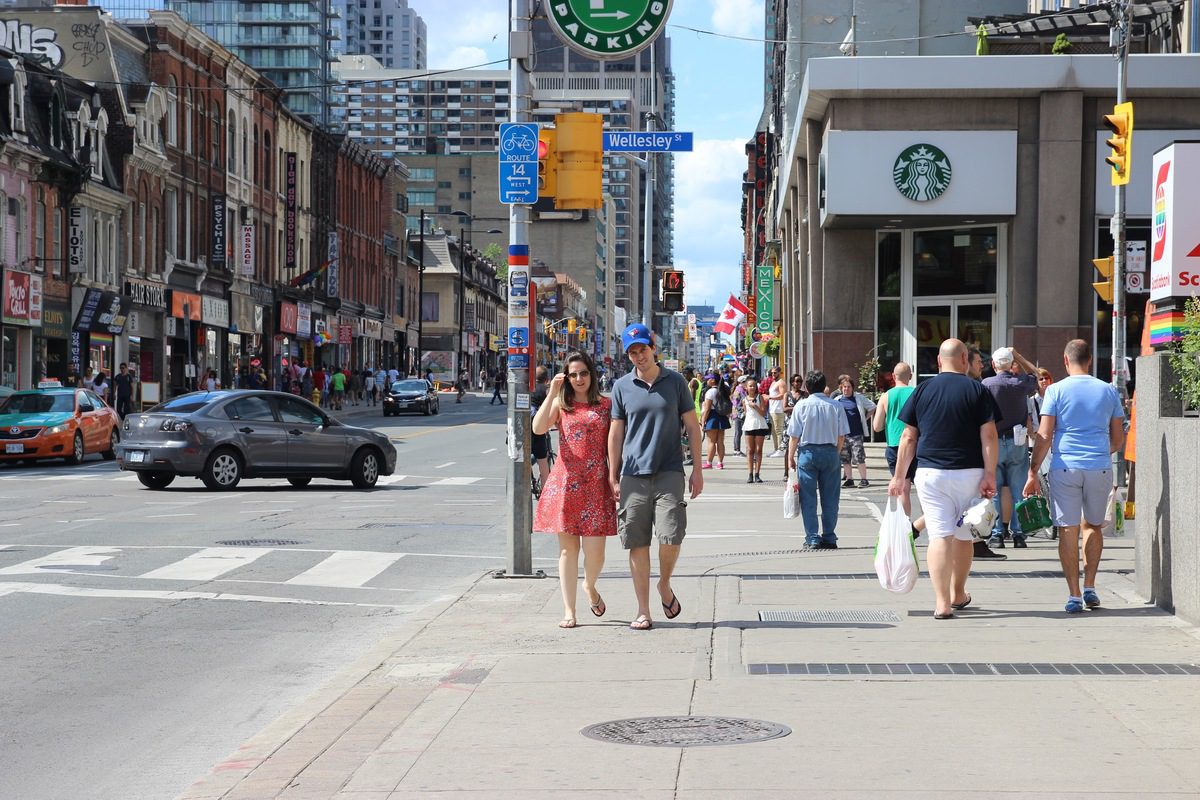Travelers to Toronto these days are typically surprised by the remarkable changes in the city over the last few years. In just a decade and a half, dozens of new and gleaming skyscrapers have been built downtown. The millennial generation has flocked to the downtown core to live a new intensely urban lifestyle. The city is vibrant and exciting in a way that wasn’t the case just ten years ago. It’s a great time to be in Toronto.
For decades the city grew like any other North American one. Endless rows of single family homes were constructed in ever more distant suburbs. Sprawl ruled the day.
AND THEN THINGS CHANGED…
In the 1990s forward looking politicians took a brave and important step. A Green Belt protecting the watersheds and forests that surround the city was created. Development was banned within the Green Belt. Once the suburbs hit that ring, the suburban sprawl came to a screeching stop. Almost overnight development patterns changed. The city began building up rather than out. Dozens of condo towers were constructed. Formerly neglected patches of undeveloped land downtown were snapped up and developed. The asphalt parking lots that used to be common downtown have disappeared. The core of the city is undergoing a remarkable densification.
Millennials are taking over
Filling up all the new condo buildings are members of the single largest demographic in the country, the millennials. Herds of young twenty-somethings have migrated into the downtown core, are taking up a lifestyle based around walkable neighbourhoods, biking, public transportation and condo living.
The millennials don’t want to be trapped in the suburban life their parents led. They don’t want the suburban home accessed only by car. They’re living more European, walking and biking to work, enjoying the urban nightlife in the evening, going home only to sleep.
The urban hipsters have arrived. They’re living in the city itself. They’re filling up all the new glass towers, and that has driven demand for units in these buildings higher and higher says Sherille Layton, a realtor with The Torontoism team:
This young generation, they don’t want a car. They have bought into the idea of urban living.
They don’t want to waste three hours a day commuting and stuck in traffic jams. Instead they want the latest smartphone, a big data plan, and a condo downtown to live in.
The fact that this generation is often locked out of owning a single family home in the city because of high prices is also driving the boom in condo development.
The residential market we’ve got is tough. It’s hard to get into. So a lot more first-time buyers are getting into condos. They can’t get into housing market but they still want to live downtown.
And why would they not?
The world’s most diverse city
Toronto seems to be changing day-by-day right now. The restaurant scene has exploded. The city contains the headquarters of Canada’s five big banks. The Ontario government is here. So is the biggest city hall in the country. Thousands are employed by the sprawling Toronto Transit Commission. One of the best universities in the world is in the downtown core (the University of Toronto). As is the headquarters of the national broadcaster, CBC, and many film and media companies. That means there are lots of different jobs, including those in tech, government, academic, media and finance. It’s all within a couple square kilometres served by a subway and streetcars.
People from every corner of the planet have come together to make the city one that is arguably the world’s most diverse. It’s an interesting, exciting place.
Sherille brings a bit of international flavour to her job. British-born she is now dedicated Torontonian. She’s witnessed the shift toward condo living.
According to Sherille the new young urban millennials stick to the bigger buildings that have gone up in the downtown core. Typically found in trendy neighbourhoods like Liberty Village, Queen West, City Place, Leslieville and Queen’s Quay these buildings offer what it is this younger generation is looking for:
A lot of the people buying downtown are between 20 and 30. The new young urban dweller wants a couple of things. They want to have a walkable neighbourhood. They want a low maintenance building. They want easy access to transit. They want low monthly fees. They don’t necessarily want the gym or the big pool as they don’t have as much money as more established people
However, many in this generation are not owners of units in these condo buildings. Investors buy the units and rent them out.
Of course, Sherille is careful to note that some of the buildings in this market sector are fairly priced these days:
Some of these areas are over-saturated. There are lots of bachelors with one bedroom and without parking. If you’ve got a two or four year plan you’re not going to make much on one of these buildings.
But there are many other areas of the condo market that are doing much better. To get a sense of why this is it helps to understand the basic types of condo units on the market.
Condo inventory
Queen West Candy Factory Lofts by Mateen Mahboubi
Hard Lofts
Genuine loft spaces in 19th century brickbuildings. Sherille says that there are relatively few authentic loft buildings available any more downtown. To be considered authentic you’ve got to be in a really old building.
Soft Lofts
These are units in buildings that have been built recently. They have floor-to-ceiling windows, very high ceilings. There are industrial ducts going through, pillars and concrete. It’s the kind of look that appeals to the new young urbanites, Sherille explained.
Older, better established buildings
These are the buildings Sherille’s more mature clients look for. Her clientele are often baby boomers who also want to get out of the suburbs and went to live downtown in a place where they have a simpler easy life without all the maintenance a house requires:
The clients I have are a bit older. When I sell condos I typically sell to established couples. A lot of people 50 to 70 are downsizing. Usually they’re looking at older buildings. The maintenance fees are higher. But there’s a lot of square footage in these buildings
The advantages in an older established building are legion. They are well run, large, and in Sherille’s experience inhabited by the older generation professionals or retirees:
I just sold a condo in a co-op building in Rosedale. It’s full of law professors.
Rosedale, of course, is one of the premier, high-end, serious money neighbourhoods in the city. Along with other affluent neighbourhoods such as Forest Hill, Richmond Hill, Leaside, Lawrence Park and Hogg’s Hollow, these are the neigborhoods found a bit north of the downtown along the north-south Yonge Street subway.
Well-off professionals in these neighbourhoods typically develop a sense of what buildings they like and keep a sharp eye our for ads announcing a sale at specific properties.
Some of the older crowd, they have a handful of buildings they’re interested in. Those buildings don’t have units come up for sale all that often. And so when one does they tend to attract multiple offers. That kind of bidding situation is more common in these buildings.
How much does owning a condo cost
Once a unit is acquired there are ongoing costs to keep in mind. Every condo building charges maintenance fees to pay the concierge, landscapers and other expenses. When it comes to figuring out what’s included in these fees you’ll find that every building is unique.
According to Sherille, monthly condo fees can range from $300-$350 in lower price unit to $1,500 or $1,700 in an older well-run condo.
One new trend in the condo sector is the hiring of an inspector before the deal is signed. Having an inspection come in and look at a home before it is acquired by a buyer is standard in the residential home market. Having an inspector come in and look over a condo is becoming a thing as well.
One of the advantages of condo living to owning a house is the length of such inspection. While it can take as much as three hours in a house, condo can be checked in 45 minutes.
The future of Toronto’s real estate market
When it comes to answering the big question—will the market keep going up?—there is an endless array of opinion. There is no doubt that the Toronto housing market has been growing sharply for years now. Commentators have predicted that strong increases in price will have to slow in the years ahead. And it does appear the number of listings is beginning to slow. Many expect a tempering of current growth rates by 2017. But prices continue to appreciate, including a 21 per cent increase this July compared to the same period last year.
The bullish point out a key factor: The number of new people moving to Toronto each year still exceeds the available supply of units.
Canada is a country of immigrants. The government brings in 250,000 permanent residents every year. One quarter of those will settle in Toronto. And so many think that even with all the new construction there are still not enough new units being built for the all the newcomers.
To put it in economic terms—demand is still going to outstrip supply for years yet. And that bodes well for the housing market.
Sherille’s point of view:
Everybody keeps saying, ‘The condo market has to be going down. There’s going to be so much product. How can the market do so well?’ But it’s still doing well. In certain areas, with a good view, you still get multiple offers on condos. It’s not as bad as the housing market where there are multiple offers on every house. But in some of the older buildings I’ve been in more multiple offers situations
There is no doubt the growth and excitement bubbling up downtown has lent to the optimism. But people living downtown feel as if there is a sort-of renaissance moment happening in the city. Toronto is finally kind of coming of age.
Toronto experts weigh in on the state of the market
Local elites recently gathered at an event put on by financial news giant Bloomberg. Those gathered talked about the optimistic outlook on Toronto real estate. One of the experts was quoted saying that Canada is now considered a, “Switzerland for educated affluent foreigners looking for a stable country they can call home.” The city is located in a cool climate. There’s lots of fresh water around. The country of Canada is stable. It is said wealthy Chinese fleeing economic and political stagnation in their home country are buying properties in Canada.
The city’s popular chief planner, Jennifer Keesmaat, said:
Many cities would scream for the kind of growth we have in Toronto…We went through a phase where we were seeking to bring people to the downtown core—that has now been accompanied by an incredible increase in employment.
According to Jennifer, office towers are “springing up downtown because businesses want to be close to the people they’re employing.” This fact was recently confirmed by a study that found Toronto has the lowest rate of vacancy in downtown office space of any city in Canada.
Another fact that those knowledgeable about the Toronto condo market cite as a reason for confidence is the fact that the Toronto condo market is not as risky as other cities.
An important city bylaw states that a condo cannot be built unless 60 per cent to 75 per cent of the units have been pre-sold.
That is, projects don’t begin construction unless they are viable. Stalled projects are very rare in the Toronto market. It stands out against other cities in this respect.
Meet the new Toronto
At the same time the downtown continues to improve and evolve to accommodate the new urban lifestyle of condo dwellers. New bike lanes are being built on the main east west artery, Bloor Street. At the beginning of August the mayor of the city, John Tory, announced a major project that will see a major rail yard servicing Union Station covered over with a roof and a massive park built on top, right in the downtown core. Commentators were already calling the plan a major legacy project in the life of the city, are comparing it the construction of Central Park in New York.
So it’s an exciting time to be in the city. It’s bursting with growth and revived energy. The city is home to important cultural movements and communities, including the one that produced the cities first globally successful Hip-Hop star, Drake. As Keesmaat put it when she tweeted out news of the new park to followers, “It’s our moment, Toronto.”




